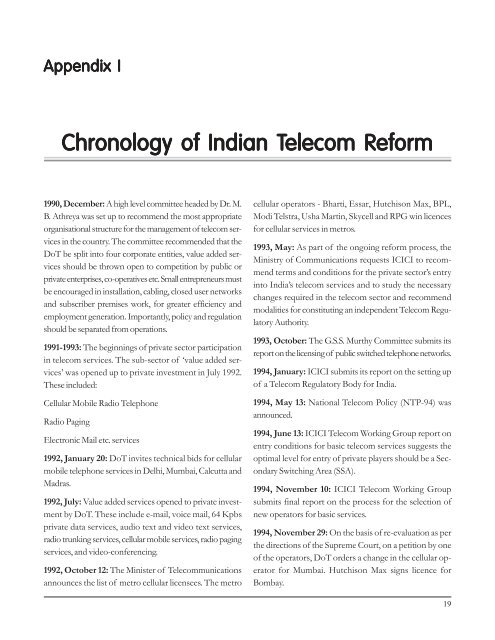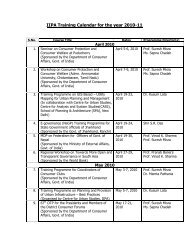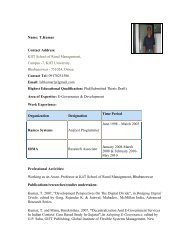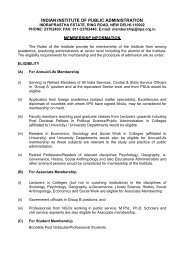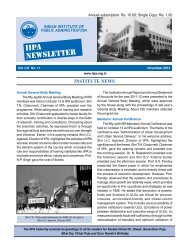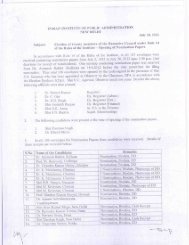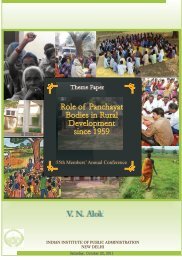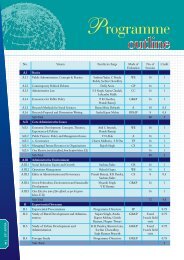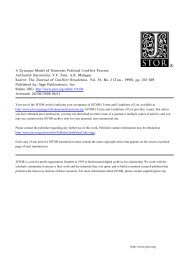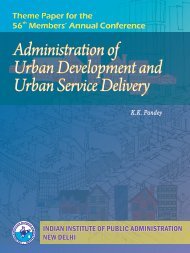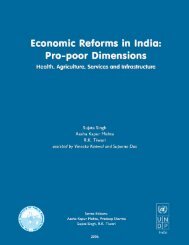India's Telecom Reform - Indian Institute of Public Administration
India's Telecom Reform - Indian Institute of Public Administration
India's Telecom Reform - Indian Institute of Public Administration
Create successful ePaper yourself
Turn your PDF publications into a flip-book with our unique Google optimized e-Paper software.
Appendix I<br />
Chronology <strong>of</strong> <strong>Indian</strong> <strong>Telecom</strong> <strong>Reform</strong><br />
1990, December: A high level committee headed by Dr. M.<br />
B. Athreya was set up to recommend the most appropriate<br />
organisational structure for the management <strong>of</strong> telecom services<br />
in the country. The committee recommended that the<br />
DoT be split into four corporate entities, value added services<br />
should be thrown open to competition by public or<br />
private enterprises, co-operatives etc. Small entrepreneurs must<br />
be encouraged in installation, cabling, closed user networks<br />
and subscriber premises work, for greater efficiency and<br />
employment generation. Importantly, policy and regulation<br />
should be separated from operations.<br />
1991-1993: The beginnings <strong>of</strong> private sector participation<br />
in telecom services. The sub-sector <strong>of</strong> ‘value added services’<br />
was opened up to private investment in July 1992.<br />
These included:<br />
Cellular Mobile Radio Telephone<br />
Radio Paging<br />
Electronic Mail etc. services<br />
1992, January 20: DoT invites technical bids for cellular<br />
mobile telephone services in Delhi, Mumbai, Calcutta and<br />
Madras.<br />
1992, July: Value added services opened to private investment<br />
by DoT. These include e-mail, voice mail, 64 Kpbs<br />
private data services, audio text and video text services,<br />
radio trunking services, cellular mobile services, radio paging<br />
services, and video-conferencing.<br />
1992, October 12: The Minister <strong>of</strong> <strong>Telecom</strong>munications<br />
announces the list <strong>of</strong> metro cellular licensees. The metro<br />
cellular operators - Bharti, Essar, Hutchison Max, BPL,<br />
Modi Telstra, Usha Martin, Skycell and RPG win licences<br />
for cellular services in metros.<br />
1993, May: As part <strong>of</strong> the ongoing reform process, the<br />
Ministry <strong>of</strong> Communications requests ICICI to recommend<br />
terms and conditions for the private sector’s entry<br />
into India’s telecom services and to study the necessary<br />
changes required in the telecom sector and recommend<br />
modalities for constituting an independent <strong>Telecom</strong> Regulatory<br />
Authority.<br />
1993, October: The G.S.S. Murthy Committee submits its<br />
report on the licensing <strong>of</strong> public switched telephone networks.<br />
1994, January: ICICI submits its report on the setting up<br />
<strong>of</strong> a <strong>Telecom</strong> Regulatory Body for India.<br />
1994, May 13: National <strong>Telecom</strong> Policy (NTP-94) was<br />
announced.<br />
1994, June 13: ICICI <strong>Telecom</strong> Working Group report on<br />
entry conditions for basic telecom services suggests the<br />
optimal level for entry <strong>of</strong> private players should be a Secondary<br />
Switching Area (SSA).<br />
1994, November 10: ICICI <strong>Telecom</strong> Working Group<br />
submits final report on the process for the selection <strong>of</strong><br />
new operators for basic services.<br />
1994, November 29: On the basis <strong>of</strong> re-evaluation as per<br />
the directions <strong>of</strong> the Supreme Court, on a petition by one<br />
<strong>of</strong> the operators, DoT orders a change in the cellular operator<br />
for Mumbai. Hutchison Max signs licence for<br />
Bombay.<br />
19


